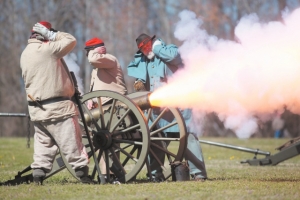On the battlefield
By Rochelle Moore
Published in News on March 4, 2018 3:05 AM

News-Argus/CASEY MOZINGO
Soldiers rip the end off of their paper gun powder pouches during a gun drills demonstration Saturday.

News-Argus/CASEY MOZINGO
History marched into Wayne County over the weekend as the sound of muskets and cannon blasts could be heard from the Goldsborough Bridge Battlefield in Dudley.
Close to 150 re-enactors, some traveling from as far as Canada, took to the battlefield Saturday during a living history weekend.
"They just have a love for the hobby, a love of history," said Lynn Bull, a member of the Goldsborough Bridge Battlefield Association, dressed in a Confederate private uniform.
"I've been doing this since 1969. I like the camaraderie and I like camping out."
Re-enactors set up camp Friday night at the battleground site, along Old Mount Olive Highway, slept in their tents and cooked over open fires, with many eating foods similar to those during Civil War times.
"Some people, they like to make it authentic to 150 years ago," said Randy Sauls, president and founder of the Goldsborough Bridge Battlefield Association, event host.
The living history and battalion drills Saturday offered the public a chance to go back into history to see how soldiers performed marching drills, tactical maneuvers, loaded their muskets and participated in infantry drills.
Reproduced cannons and Enfield Pattern rifle muskets were shot at 11 a.m. and 2 p.m., with black powder and blanks.
The .577-caliber, muzzle-loading rifle muskets had the capacity to fire anywhere from 400 to 600 yards during the war. It also took 112 rounds of gunfire for each casualty, a re-enactor explained during a muzzle-loading demonstration.
Members of the 1st North Carolina Battalion, dressed in uniforms made from jean cloth, a blend of wool and cotton used by Confederate soldiers, went through different drills throughout the day and brought to life the Napoleonic warfare, face-to-face combat, style used during the Civil War.
"Back then, they lined up, shoulder-to-shoulder," Sauls said. "It's important to understand that's how our ancestors did it. All these things are important to understand our past."
During the drills, a soldier held the first national flag of the Confederate government, which included 11 stars representing the states.
The Goldsborough Bridge Battlefield Association was founded 10 years ago in an effort to preserve history and the site of a Civil War battle.
The re-enactment was held early in the year, before other larger re-enactments take place across the state and nation, Sauls said.
"This is a small living history," Sauls said. "They like doing it here because it's centrally located. Having fun is a big part of it but also learning.
"In addition to preserving and developing this as a historical site, we like to have programs out here to educate the public about the way things used to be, whether good or bad."
The Goldsborough Bridge Battlefield is known as the site of the Dec. 17, 1862, Battle of Goldsborough Bridge where 15,000 Union and Confederate soldiers fought for control of the strategic railroad bridge, used to transport supplies, over the Neuse River.
The bridge was destroyed but Confederate soldiers rebuilt the bridge within six to eight weeks and stationed a regiment at the site until the end of the war, said Bryson Bateman, member of the Goldsborough Bridge Battlefield Association.
Betty Jo Sauls Smith went to see the living history and visited the battleground site for the first time Saturday. She was surprised most by the conditions soldiers endured during the late 1800s, with braving the outdoor elements and face-to-face combat.
"I just had to see what this is all about," she said. "What they went through, compared to our service men today, and what they went through is just amazing. It was just rough on them. It's just amazing what they went through for us."
